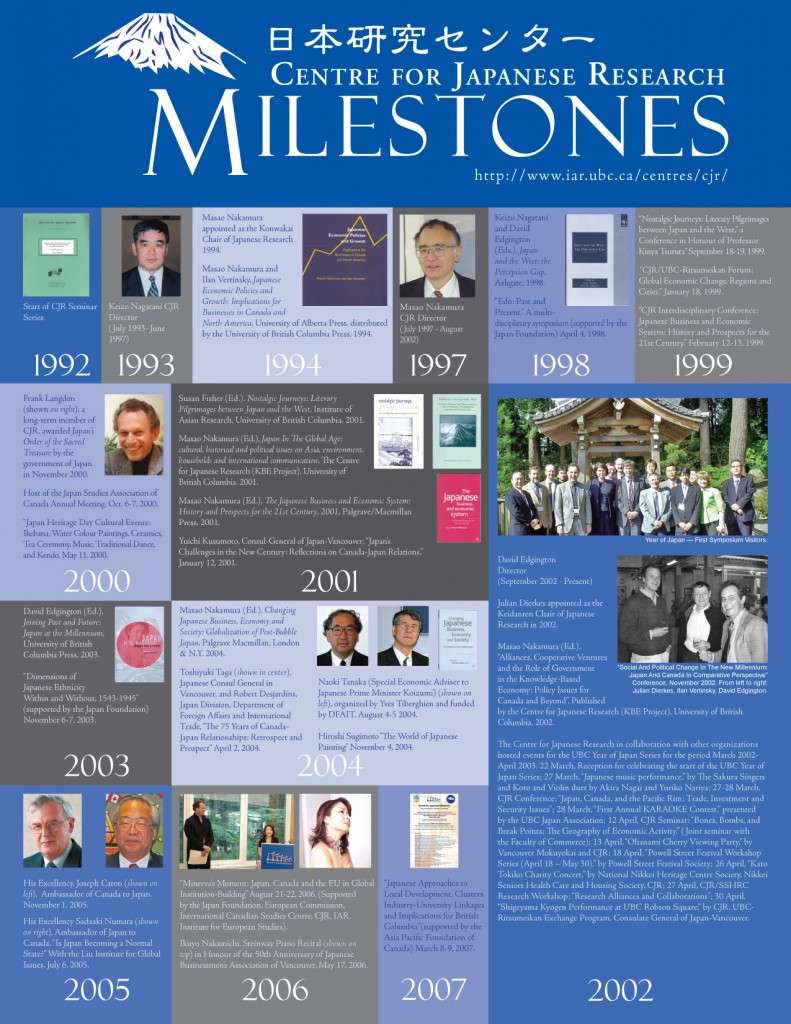PAST DIRECTORS
- Keizo Nagatani (July 1993 – June 1997)
- Masao Nakamura (July 1997 – August 2002)
- David Edgington (September 2002 – June 2009)
- [Julian Dierkes, Acting Director (September 2004 – June 2005)]
- [Bill Wray, Acting Director (July 2009 – June 2010)]
- Julian Dierkes (July 2010 – June 2014)
- Christina Laffin and Shige Matsui (September 2014 – August 2018)
- Current Co-directors: Joshua S. Mostow and Yves Tiberghien (August 2018-present)
A BRIEF HISTORY OF THE CENTRE
Researchers at the University of British Columbia have had a long history of research interest in Asia. In the area of Japan studies, for example, researchers such as Ronald Dore, Mark Fruin and Frank Langdon, who all became well-known scholars subsequently, were affiliated with UBC in the 1960s and 1970s to pursue their original research on contemporary Japanese society. Reflecting general interest in Asia in the university community, UBC founded in 1978 within the Faculty of Graduate Studies the Institute of Asian Research to generate research and coordinate its activities on Asia.
The Institute was restructured in 1991 to include five regional research centres (CJR being one of them) with an expanded mandate to promote interdisciplinary research on Asia-Pacific. The expansion was made possible by more than $20 million in endowments and grants raised through the UBC World of Opportunity Campaign undertaken by then UBC President, Dr. David W. Strangway.
The funding for creating CJR in 1991 was made possible by the efforts of Konwakai (the Vancouver Japanese Businessmen’s Association), Keidanren (the Japan Federation of Economic Organizations) and friends, and the Government of British Columbia. In addition Konwakai and friends raised funds for the $1 million renovation of the Nitobe Memorial Garden on the UBC campus. The renovation was completed in April 1993. Additional funding provided by Dr. Soshitsu Sen XV, the Grand Master of the Urasenke Foundation, was used to complete in July 1993 the restoration of the Nitobe Memorial Garden Teahouse. The Teahouse is used for the teaching and practice of chanoyu, the Japanese tea ceremony.
CJR began its series of seminars on Japan-related topics of general interest in 1992 when Mark Fruin became the director of the Institute of Asian Research. The Institute was originally located in the Asian Centre building. However, it was in 1995 when the new C. K. Choi Building for the Institute of Asian Research was completed that CJR for the time was given its own office space including faculty offices for endowed chairs, the centre director and visiting scholars and also some desk spaces for graduate students and visiting scholars.
By the mid 1990s funding for CJR’s two endowed chairs and CJR’s research program became finalized. Keizo Nagatani (Department of Economics) became the director of CJR (1993-1997). After Nagatani’s departure from UBC, Masao Nakamura (IAR, Business and Applied Science) became the second director (1997-2002) and then David Edgington (Geography) the third (2002-2005). CJR’s endowed chair positions facilitated hiring of Nakamura as the Konwakai Chair of Japanese Research in 1994 and Julian Dierkes as the Keidanren Chair of Japanese Research in 2002.
Beginning in 1993 CJR began subsidizing Japan-related research projects of the CJR-affiliated faculty and Ph.D. students. Over time these research projects have resulted in many publications and Ph.D. theses. CJR also promotes research seminars, workshops and conferences on Japan-related topics by subsidizing the projects sponsored by the Social Science and Humanity Research Council of Canada, the Japan Foundation and UBC’s own funding from outside the Institute. These research projects cover not only what is known as the traditional research topics on Japan but also newer topics in Japanese studies such as environment, management, psychology and technology.
In addition to scholarly research CJR from its beginning has been actively involved in promoting interest in Japan among members of Canadian society, another mandate for CJR. For this purpose CJR held a number of workshops and discussion forums on contemporary management and environment issues for the local business community. Some of CJR presentations on Japanese literature and other cultural activities have also served this purpose. For example, CJR had two well-known Akutagawa Literature Prize winners recently as its seminar speakers: Fumiko Kometani (1998) and Yoko Tawada (1999, joint with the Goethe Institute Vancouver). More recently CJR organized and hosted the UBC Year of Japan Series for the period March 2002-April 2003 on behalf of the University (co-chaired by Moritaka Matusmoto and Masao Nakamura). The Series presented many Japan-related scholarly seminars as well as performing arts and other public performance presentations including music, Noh, Bunraku and Kyogen plays given by visitors from various parts of Canada and Japan.
To help CJR and UBC to promote interest in Japanese culture among members of Canadian society some members of the Japanese community have donated valuable artistic objects from Japan to CJR. They include many original Noh-play masks produced by Noh-mask artists in Hiroshima (1996), the original Yamazaki Kyoto Kicho silk screens (1998) and hanging art pieces from Kyoto. Some of these are exhibited in the CJR meeting room.
CJR thanks Julian Dierkes (2004-2005, July 2010-June 2014) for his five years of service as the CJR director and for his leadership and guiding vision. CJR thanks co-directors Christina Laffin and Shige Matsui (September 2014 – August 2018) for their years of service and continued role in supporting the Centre. Current co-directors Joshua Mostow and Yves Tiberghien look forward to seeing you at our regular events.
CJR MILESTONES
